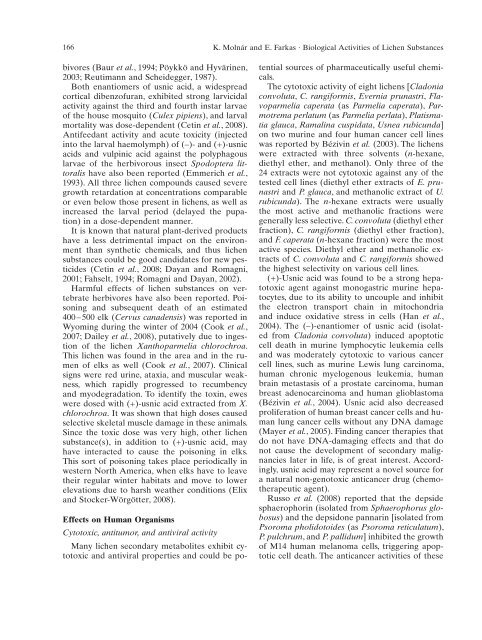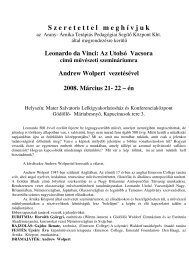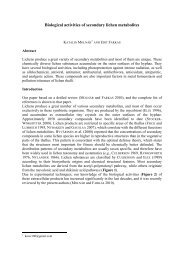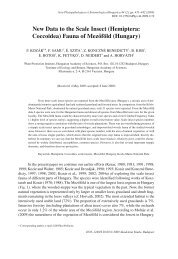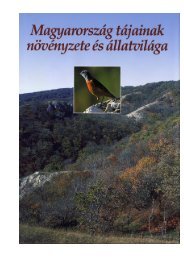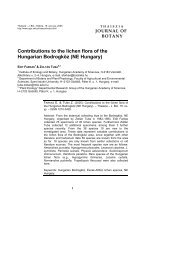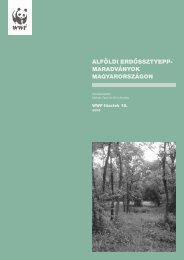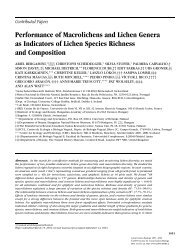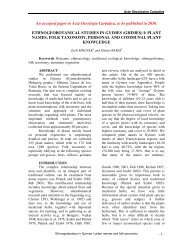Current Results on Biological Activities of Lichen ... - Lichens and Me
Current Results on Biological Activities of Lichen ... - Lichens and Me
Current Results on Biological Activities of Lichen ... - Lichens and Me
Create successful ePaper yourself
Turn your PDF publications into a flip-book with our unique Google optimized e-Paper software.
166 K. Molnár <strong>and</strong> E. Farkas · <strong>Biological</strong> <strong>Activities</strong> <strong>of</strong> <strong>Lichen</strong> Substances<br />
bivores (Baur et al., 1994; Pöykkö <strong>and</strong> Hyvärinen,<br />
2003; Reutimann <strong>and</strong> Scheidegger, 1987).<br />
Both enantiomers <strong>of</strong> usnic acid, a widespread<br />
cortical dibenz<strong>of</strong>uran, exhibited str<strong>on</strong>g larvicidal<br />
activity against the third <strong>and</strong> fourth instar larvae<br />
<strong>of</strong> the house mosquito (Culex pipiens), <strong>and</strong> larval<br />
mortality was dose-dependent (Cetin et al., 2008).<br />
Antifeedant activity <strong>and</strong> acute toxicity (injected<br />
into the larval haemolymph) <strong>of</strong> (–)- <strong>and</strong> (+)-usnic<br />
acids <strong>and</strong> vulpinic acid against the polyphagous<br />
larvae <strong>of</strong> the herbivorous insect Spodoptera littoralis<br />
have also been reported (Emmerich et al.,<br />
1993). All three lichen compounds caused severe<br />
growth retardati<strong>on</strong> at c<strong>on</strong>centrati<strong>on</strong>s comparable<br />
or even below those present in lichens, as well as<br />
increased the larval period (delayed the pupati<strong>on</strong>)<br />
in a dose-dependent manner.<br />
It is known that natural plant-derived products<br />
have a less detrimental impact <strong>on</strong> the envir<strong>on</strong>ment<br />
than synthetic chemicals, <strong>and</strong> thus lichen<br />
substances could be good c<strong>and</strong>idates for new pesticides<br />
(Cetin et al., 2008; Dayan <strong>and</strong> Romagni,<br />
2001; Fahselt, 1994; Romagni <strong>and</strong> Dayan, 2002).<br />
Harmful effects <strong>of</strong> lichen substances <strong>on</strong> vertebrate<br />
herbivores have also been reported. Pois<strong>on</strong>ing<br />
<strong>and</strong> subsequent death <strong>of</strong> an estimated<br />
400 – 500 elk (Cervus canadensis) was reported in<br />
Wyoming during the winter <strong>of</strong> 2004 (Cook et al.,<br />
2007; Dailey et al., 2008), putatively due to ingesti<strong>on</strong><br />
<strong>of</strong> the lichen Xanthoparmelia chlorochroa.<br />
This lichen was found in the area <strong>and</strong> in the rumen<br />
<strong>of</strong> elks as well (Cook et al., 2007). Clinical<br />
signs were red urine, ataxia, <strong>and</strong> muscular weakness,<br />
which rapidly progressed to recumbency<br />
<strong>and</strong> myodegradati<strong>on</strong>. To identify the toxin, ewes<br />
were dosed with (+)-usnic acid extracted from X.<br />
chlorochroa. It was shown that high doses caused<br />
selective skeletal muscle damage in these animals.<br />
Since the toxic dose was very high, other lichen<br />
substance(s), in additi<strong>on</strong> to (+)-usnic acid, may<br />
have interacted to cause the pois<strong>on</strong>ing in elks.<br />
This sort <strong>of</strong> pois<strong>on</strong>ing takes place periodically in<br />
western North America, when elks have to leave<br />
their regular winter habitats <strong>and</strong> move to lower<br />
elevati<strong>on</strong>s due to harsh weather c<strong>on</strong>diti<strong>on</strong>s (Elix<br />
<strong>and</strong> Stocker-Wörgötter, 2008).<br />
Effects <strong>on</strong> Human Organisms<br />
Cytotoxic, antitumor, <strong>and</strong> antiviral activity<br />
Many lichen sec<strong>on</strong>dary metabolites exhibit cytotoxic<br />
<strong>and</strong> antiviral properties <strong>and</strong> could be potential<br />
sources <strong>of</strong> pharmaceutically useful chemicals.<br />
The cytotoxic activity <strong>of</strong> eight lichens [Clad<strong>on</strong>ia<br />
c<strong>on</strong>voluta, C. rangiformis, Evernia prunastri, Flavoparmelia<br />
caperata (as Parmelia caperata), Parmotrema<br />
perlatum (as Parmelia perlata), Platismatia<br />
glauca, Ramalina cuspidata, Usnea rubicunda]<br />
<strong>on</strong> two murine <strong>and</strong> four human cancer cell lines<br />
was reported by Bézivin et al. (2003). The lichens<br />
were extracted with three solvents (n-hexane,<br />
diethyl ether, <strong>and</strong> methanol). Only three <strong>of</strong> the<br />
24 extracts were not cytotoxic against any <strong>of</strong> the<br />
tested cell lines (diethyl ether extracts <strong>of</strong> E. prunastri<br />
<strong>and</strong> P. glauca, <strong>and</strong> methanolic extract <strong>of</strong> U.<br />
rubicunda). The n-hexane extracts were usually<br />
the most active <strong>and</strong> methanolic fracti<strong>on</strong>s were<br />
generally less selective. C. c<strong>on</strong>voluta (diethyl ether<br />
fracti<strong>on</strong>), C. rangiformis (diethyl ether fracti<strong>on</strong>),<br />
<strong>and</strong> F. caperata (n-hexane fracti<strong>on</strong>) were the most<br />
active species. Diethyl ether <strong>and</strong> methanolic extracts<br />
<strong>of</strong> C. c<strong>on</strong>voluta <strong>and</strong> C. rangiformis showed<br />
the highest selectivity <strong>on</strong> various cell lines.<br />
(+)-Usnic acid was found to be a str<strong>on</strong>g hepatotoxic<br />
agent against m<strong>on</strong>ogastric murine hepatocytes,<br />
due to its ability to uncouple <strong>and</strong> inhibit<br />
the electr<strong>on</strong> transport chain in mitoch<strong>on</strong>dria<br />
<strong>and</strong> induce oxidative stress in cells (Han et al.,<br />
2004). The (–)-enantiomer <strong>of</strong> usnic acid (isolated<br />
from Clad<strong>on</strong>ia c<strong>on</strong>voluta) induced apoptotic<br />
cell death in murine lymphocytic leukemia cells<br />
<strong>and</strong> was moderately cytotoxic to various cancer<br />
cell lines, such as murine Lewis lung carcinoma,<br />
human chr<strong>on</strong>ic myelogenous leukemia, human<br />
brain metastasis <strong>of</strong> a prostate carcinoma, human<br />
breast adenocarcinoma <strong>and</strong> human glioblastoma<br />
(Bézivin et al., 2004). Usnic acid also decreased<br />
proliferati<strong>on</strong> <strong>of</strong> human breast cancer cells <strong>and</strong> human<br />
lung cancer cells without any DNA damage<br />
(Mayer et al., 2005). Finding cancer therapies that<br />
do not have DNA-damaging effects <strong>and</strong> that do<br />
not cause the development <strong>of</strong> sec<strong>on</strong>dary malignancies<br />
later in life, is <strong>of</strong> great interest. Accordingly,<br />
usnic acid may represent a novel source for<br />
a natural n<strong>on</strong>-genotoxic anticancer drug (chemotherapeutic<br />
agent).<br />
Russo et al. (2008) reported that the depside<br />
sphaerophorin (isolated from Sphaerophorus globosus)<br />
<strong>and</strong> the depsid<strong>on</strong>e pannarin [isolated from<br />
Psoroma pholidotoides (as Psoroma reticulatum),<br />
P. pulchrum, <strong>and</strong> P. pallidum] inhibited the growth<br />
<strong>of</strong> M14 human melanoma cells, triggering apoptotic<br />
cell death. The anticancer activities <strong>of</strong> these


